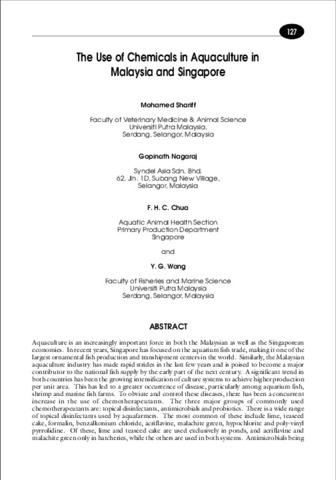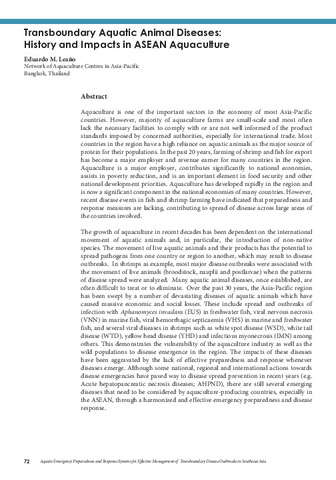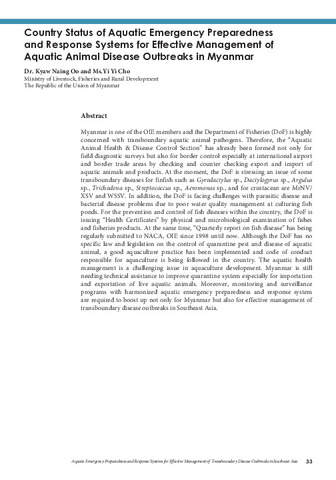The use of chemicals in aquaculture in Malaysia and Singapore
- Global styles
- MLA
- Vancouver
- Elsevier - Harvard
- APA
- Help

วันที่
2000Page views
27,813ASFA keyword
chlorophylls 
safety regulations
anaesthetics
disease control
antibiotics
zeolites
aquaculture
aquarium culture
disinfectants
probiotics
ornamental fishes
antiprotozoal agents
marine crustaceans
drugs
fish culture
policies
shrimp culture
aquaculture regulations
therapy
pond culture
saponins
hatcheries
intensive aquaculture
iodine compounds
fish diseases
dyes
disease prophylaxis
food safety
mariculture
chemical pollutants

safety regulations

anaesthetics

disease control

antibiotics

zeolites

aquaculture

aquarium culture

disinfectants

probiotics

ornamental fishes

antiprotozoal agents

marine crustaceans

drugs

fish culture

policies

shrimp culture

aquaculture regulations

therapy

pond culture

saponins

hatcheries

intensive aquaculture

iodine compounds

fish diseases

dyes

disease prophylaxis

food safety

mariculture

chemical pollutants

เมตาดาต้า
แสดงระเบียนรายการเต็ม
Share
นามธรรม
Aquaculture is an increasingly important force in both the Malaysian as well as the Singaporean economies. In recent years, Singapore has focused on the aquarium fish trade, making it one of the largest ornamental fish production and transhipment centers in the world. Similarly, the Malaysian aquaculture industry has made rapid strides in the last few years and is poised to become a major contributor to the national fish supply by the early part of the next century. A significant trend in both countries has been the growing intensification of culture systems to achieve higher production per unit area. This has led to a greater occurrence of disease, particularly among aquarium fish, shrimp and marine fish farms. To obviate and control these diseases, there has been a concurrent increase in the use of chemotherapeutants. The three major groups of commonly used chemotherapeutants are: topical disinfectants, antimicrobials and probiotics. There is a wide range of topical disinfectants used by aquafarmers. The most common of these include lime, teaseed cake, formalin, benzalkonium chloride, acriflavine, malachite green, hypochlorite and poly-vinyl pyrrolidine. Of these, lime and teaseed cake are used exclusively in ponds, and acriflavine and malachite green only in hatcheries, while the others are used in both systems. Antimicrobials being used include sulfonamides, tetracyclines, nitrofurans, chloramphenicol, oxolinic acid and virginiamycin. A number of other chemotherapeutants are also used, albeit on a limited basis. The current concerns surrounding the use of chemotherapeutants and the legislative framework surrounding their sale and distribution are also discussed.
การอ้างอิง
Mohamed, S., Nagaraj, G., Chua, F. H. C., & Wang, Y. G. (2000). The use of chemicals in aquaculture in Malaysia and Singapore. In J. R. Arthur, C. R. Lavilla-Pitogo, & R. P. Subasinghe (Eds.), Use of Chemicals in Aquaculture in Asia: Proceedings of the Meeting on the Use of Chemicals in Aquaculture in Asia, 20-22 May 1996, Tigbauan, Iloilo, Philippines (pp. 127-140). Tigbauan, Iloilo, Philippines: Aquaculture Department, Southeast Asian Fisheries Development Center.
Type
Conference paperISBN
9718511490คอลเลกชัน
Related items
Showing items related by title, author, creator and subject.
-
Transboundary aquatic animal diseases: History and impacts in ASEAN aquaculture
Leaño, Eduardo M. (Aquaculture Department, Southeast Asian Fisheries Development Center, 2019)Aquaculture is one of the important sectors in the economy of most Asia-Pacific countries. However, majority of aquaculture farms are small-scale and most often lack the necessary facilities to comply with or are not well ... -
Country status of aquatic emergency preparedness and response systems for effective management of aquatic animal disease outbreaks in Myanmar
Oo, Kyaw Naing; Cho, Yi Yi (Aquaculture Department, Southeast Asian Fisheries Development Center, 2019)Myanmar is one of the OIE members and the Department of Fisheries (DoF) is highly concerned with transboundary aquatic animal pathogens. Therefore, the Aquatic Animal Health & Disease Control Section has already been ... -
Emergency response to emerging diseases: TiLV in tilapia
Senapin, Saengchan (Aquaculture Department, Southeast Asian Fisheries Development Center, 2019)Tilapia lake virus (TiLV) is a novel RNA virus resembling Orthomyxovirus. It has been recently re-classified to Tilapia tilapinevirus species, under Tilapinevirus genus, Amnoonviridae family (ICTV, 2018). Since the first ...




